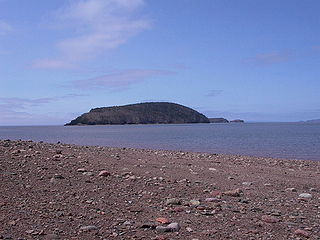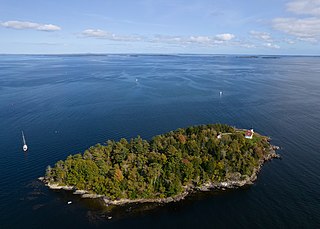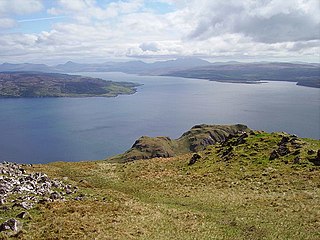
Lubec is a town in Washington County, Maine, United States. It is the easternmost municipality in the contiguous U.S. and is the country's closest continental location to Africa.

Five Islands is a rural community in Colchester County Nova Scotia with a population of 316 located on the north shore of Minas Basin, home of the highest tides in the world. It is named after five small islands – Moose, Diamond, Long, Egg, and Pinnacle – located just off the coast. The islands are an exposed part of the North Mountain Basalt. Moose Island is in Colchester County. The remaining islands are in Cumberland County. Beyond Pinnacle Island is a seastack called Pinnacle Rock.

Saint Tudwal's Islands are a small archipelago lying south of Abersoch on the Llŷn Peninsula in North Wales, at the western end of Tremadog Bay. They were referred to as the Studwells in the early 19th century. The name of the islands derives from their traditional identification as the site of a hermitage used by Saint Tudwal during the 6th century. They are about 1 kilometre (0.6 mi) east of the southern tip of the Llŷn Peninsula.

Great Duck Island is a small island in the Gulf of Maine, 11 miles (18 km) south of the entrance to Frenchman Bay, not far from Acadia National Park. Along with nearby Little Duck Island and 11 others, it is part of the town of Frenchboro.

Kalpeni is an inhabited Atoll in the Union Territory of Lakshadweep, India. It has a distance of 287 km (178 mi) west of the city of Kochi.

Bass Harbor is a village in Hancock County, Maine, United States. It is within the town of Tremont on Mount Desert Island, and near Acadia National Park. With its well-protected natural harbor, it ranks as one of the most lucrative lobster-producing ports in the state. Bass Harbor Head Lighthouse lies at the mouth of the harbor. The village is also the departure point for Maine State Ferry Service transport to Swans Island and Frenchboro.

Lake Memphremagog is a fresh water glacial lake located between Newport, Vermont, United States and Magog, Quebec, Canada. The lake spans both Quebec and Vermont, but is mostly in Quebec. Most of the watershed that feeds the lake is located in Vermont, and is a source for accumulated phosphorus, sediments, and other pollutants. Cleanup efforts since the late 1980s have improved the water quality. The lake furnishes potable water for 200,000 people.
The Stewart B. McKinney National Wildlife Refuge is a 950-acre (384.5 ha) National Wildlife Refuge in ten units across the U.S. state of Connecticut. Located in the Atlantic Flyway, the refuge spans 70 miles (110 km) of Connecticut coastline and provides important resting, feeding, and nesting habitat for many species of wading birds, shorebirds, songbirds and terns, including the endangered roseate tern. Adjacent waters serve as wintering habitat for brant, scoters, American black duck, and other waterfowl. Overall, the refuge encompasses over 900 acres (364.2 ha) of barrier beach, intertidal wetland and fragile island habitats.

McNabs Island is the largest island in Halifax Harbour located in Halifax Regional Municipality, Nova Scotia, Canada. It played a major role in defending Halifax Harbour and is now a provincial park. The island was settled by Britons in the 1750s and later by Peter McNab, and McNab family members lived on the island until 1934.

The Imperial Towers of Ontario were six of the earliest lighthouses built on Lake Huron and Georgian Bay, all constructed primarily of stone, by the Province of Canada. The origin of the designation Imperial is not certain, but some historians speculate that because the towers were public construction built under the colonial administration while Canada was a self-governing colony of Britain, the name would assure at least some funding from the British Empire's Board of Trade.

The Norwalk Islands are a chain of more than 25 islands amid partly submerged boulders, reefs and mudflats along a six-mile (10 km) stretch and mostly about a mile off the coast of Norwalk, Connecticut, and southwest Westport, Connecticut, in Long Island Sound.

The Colchester Reef Light in Vermont was a lighthouse off Colchester Point in Lake Champlain. It was moved to the Shelburne Museum in Shelburne, Vermont, in 1956.

Eilean Musdile (Mansedale) is an islet, and lighthouse to the south west of Lismore in the Inner Hebrides.
M'Clure Bay is a Peel Soundmap waterway in the Qikiqtaaluk Region, Nunavut, Canada. It is located on the western side of Somerset Island,map between Aston Baymap and Birmingham Baymap.

Curtis Island is an island located in the exterior of Camden Harbor, in Camden, Maine, United States. The island received its name in 1934 after Cyrus H. K. Curtis, publisher of the Saturday Evening Post, a long time resident and benefactor of Camden.

Battle of the Windmill National Historic Site marks the site of the November 1838 Battle of the Windmill, fought around a grist windmill near Prescott, Ontario, Canada. In 1873, the original grist windmill was converted into a lighthouse by the Canadian Department of Marine. The lighthouse became known as Windmill Point Light.

The Sound of Mull is a sound between the Inner Hebridean island of Mull and mainland Scotland. It forms part of the Atlantic Ocean.

The Island Line Trail, also known as the Colchester Causeway, is a 13.4-mile (21.6 km) rail trail located in northwest Vermont. It comprises the Burlington Bike Path (Burlington), Colchester Park (Colchester) and the Allen Point Access Area. The trail follows the route of the Island Line railroad, built by the Rutland Railroad in 1901.

Wellers Bay is a small bay on Lake Ontario, on the west side of Prince Edward County. In 1861 the Government of the Province of Canada considered making it a "harbour of refuge", and installing a lighthouse.
















